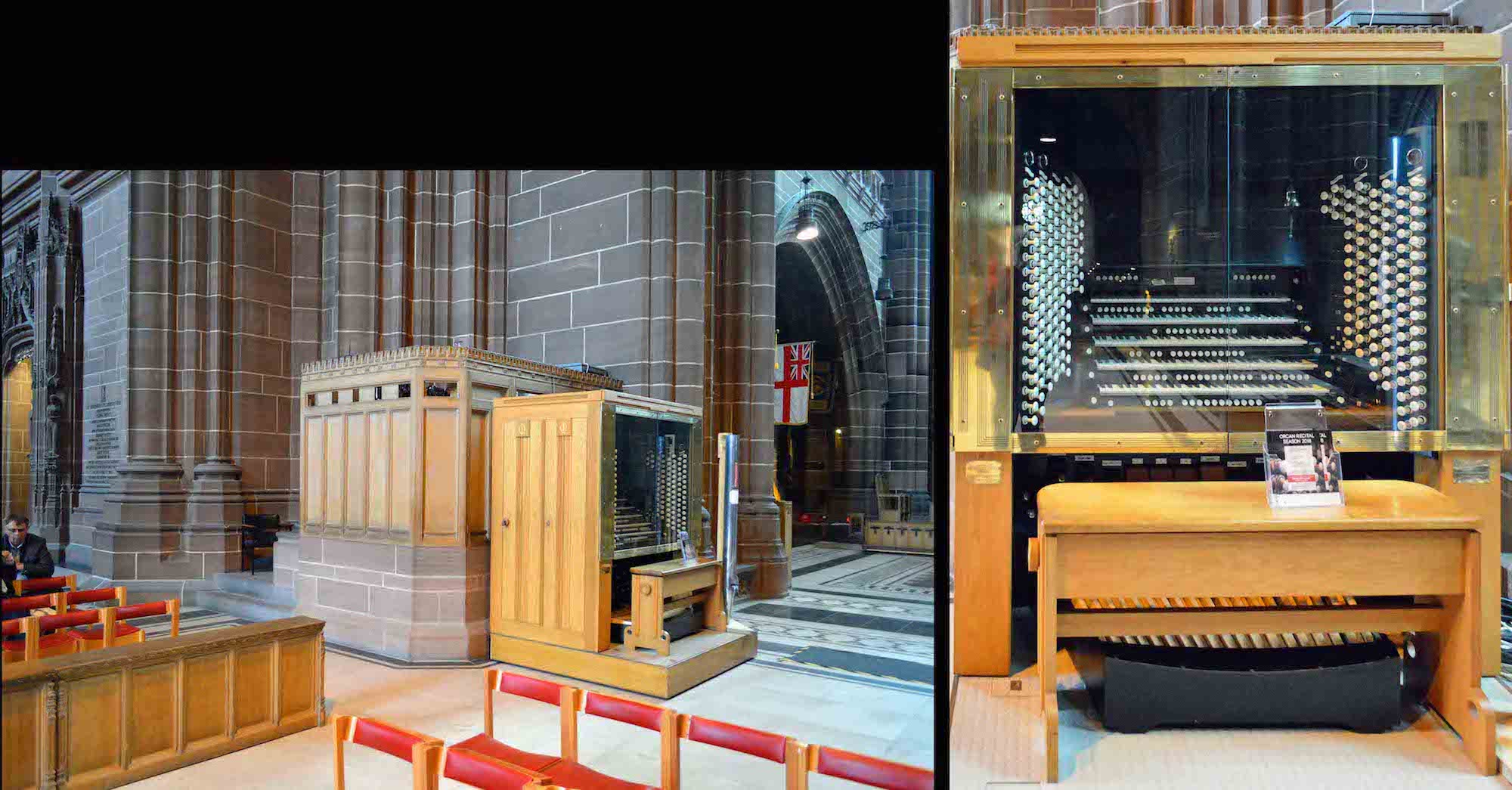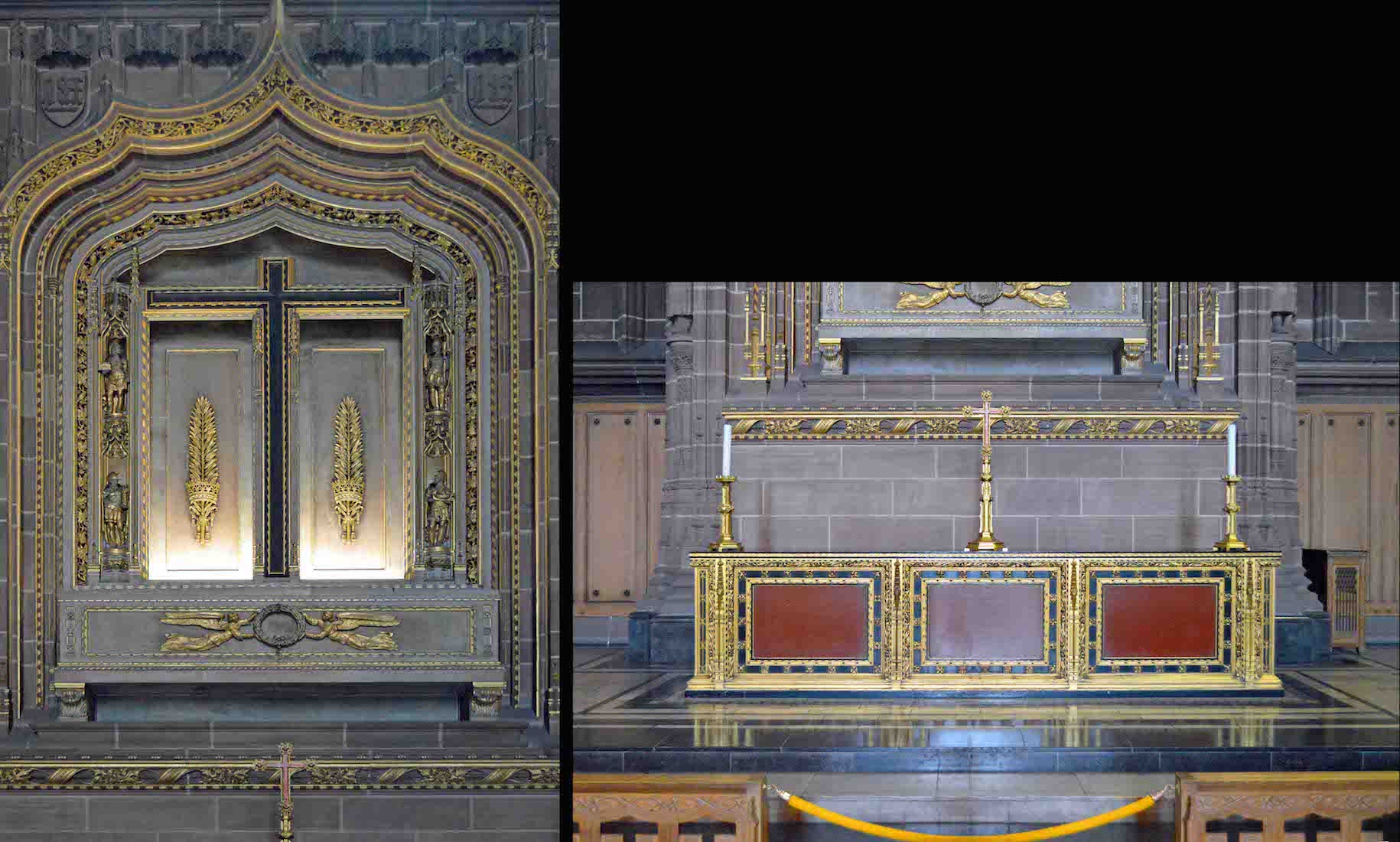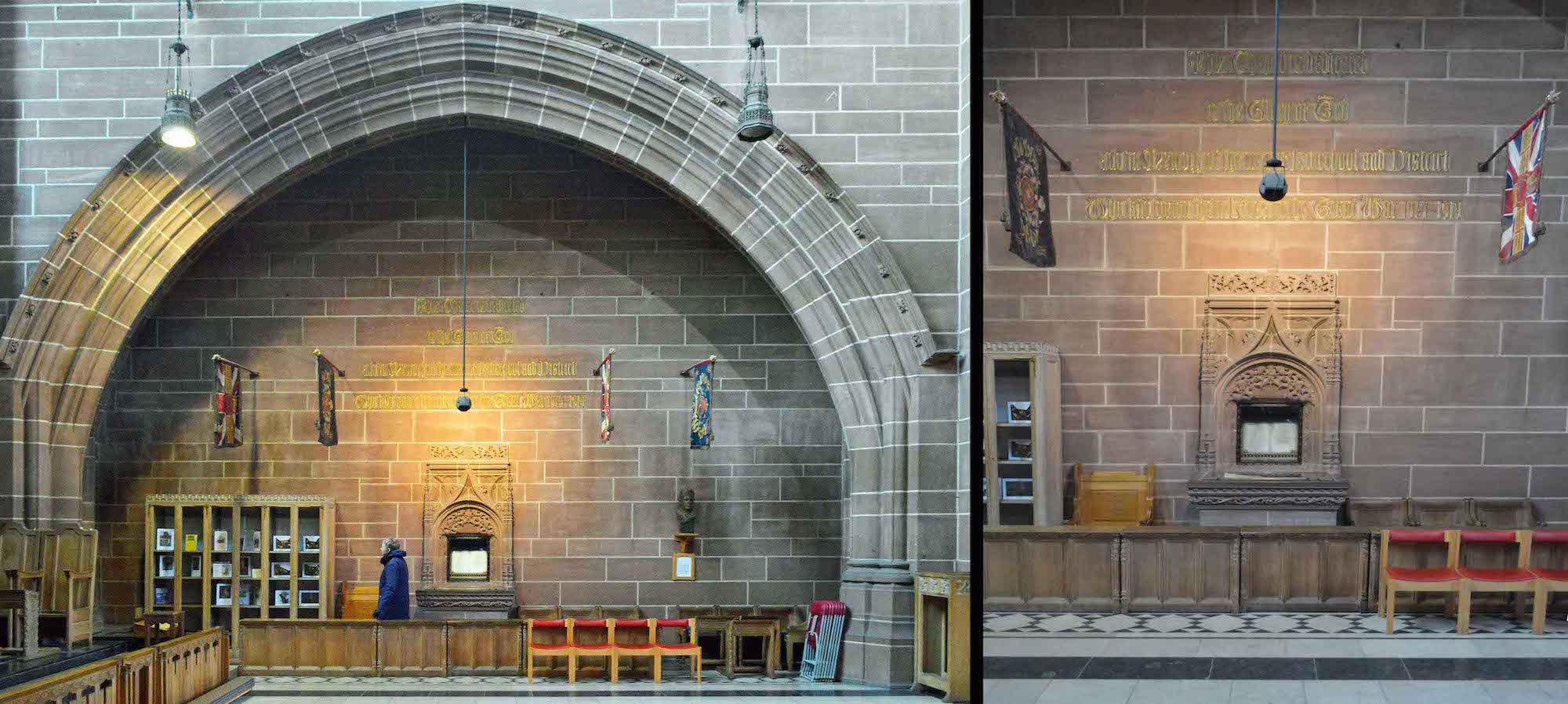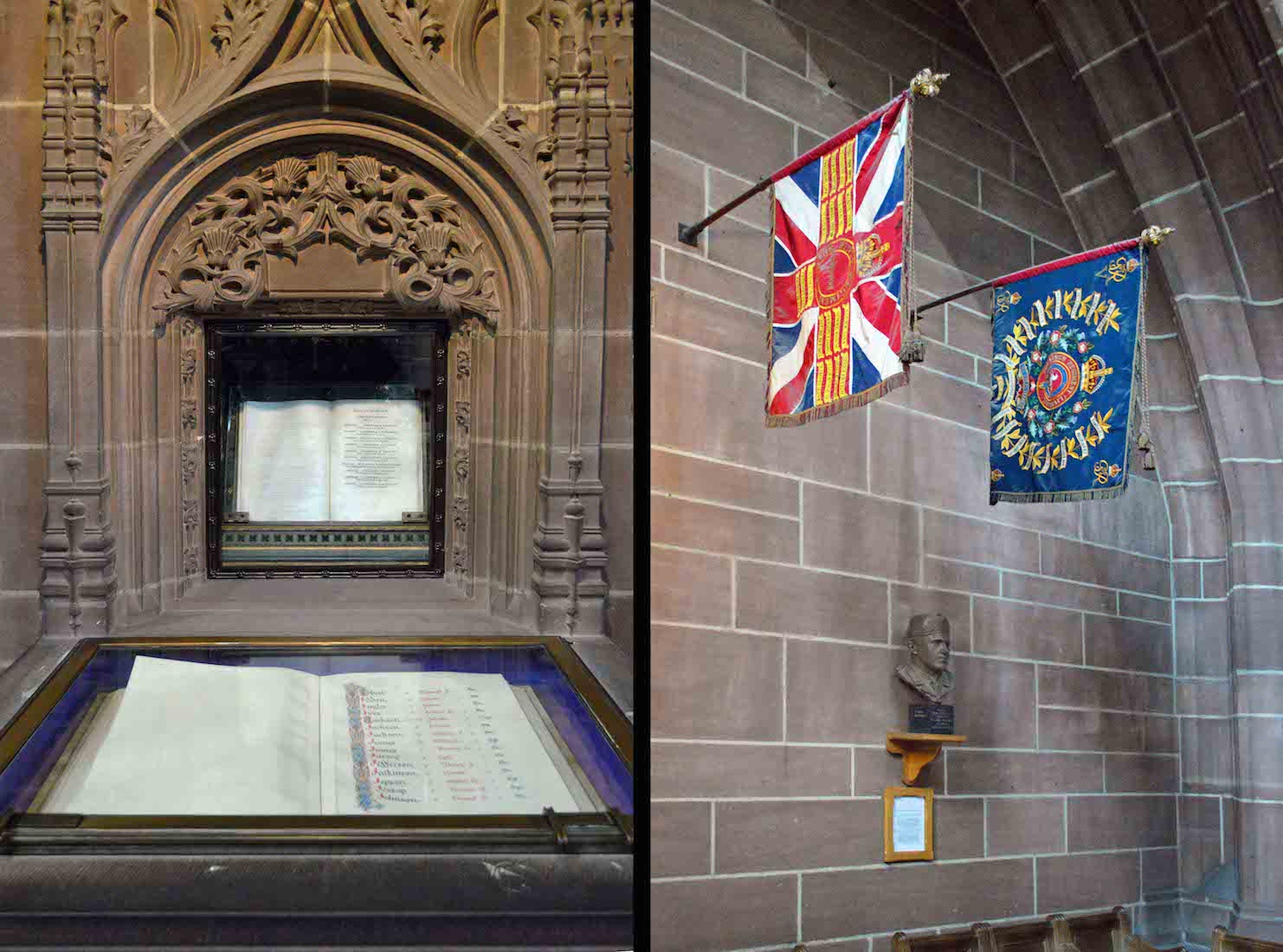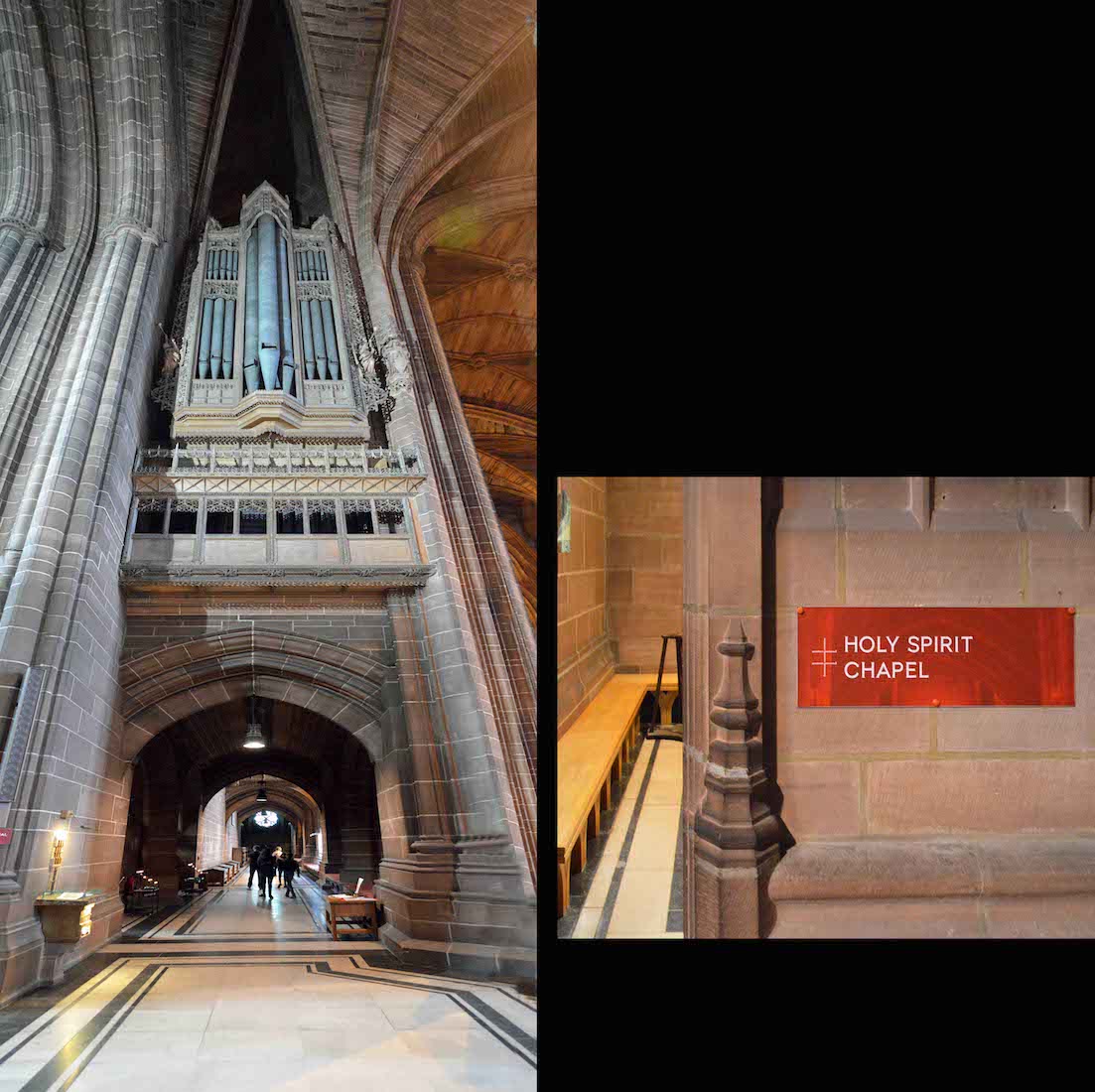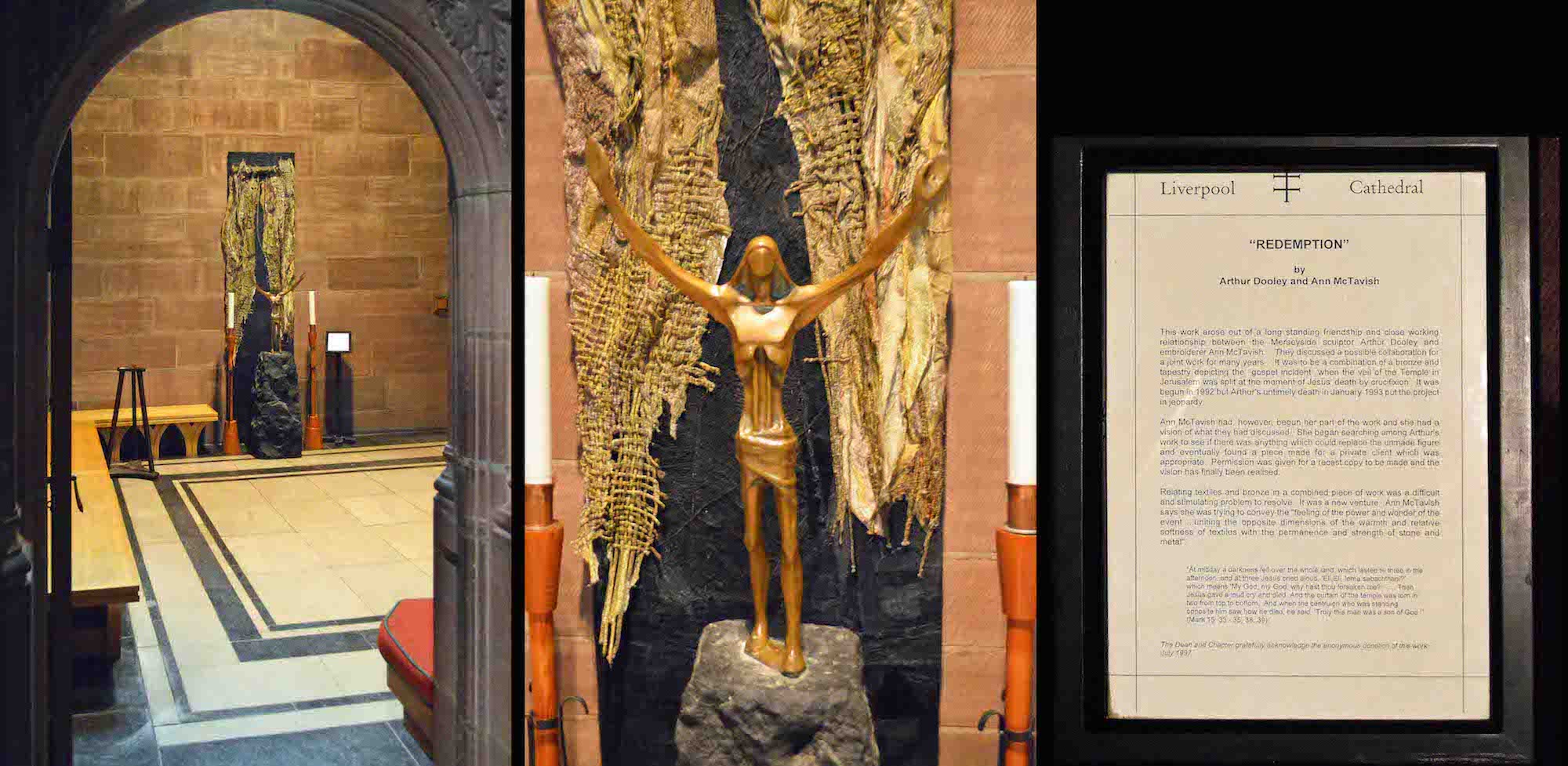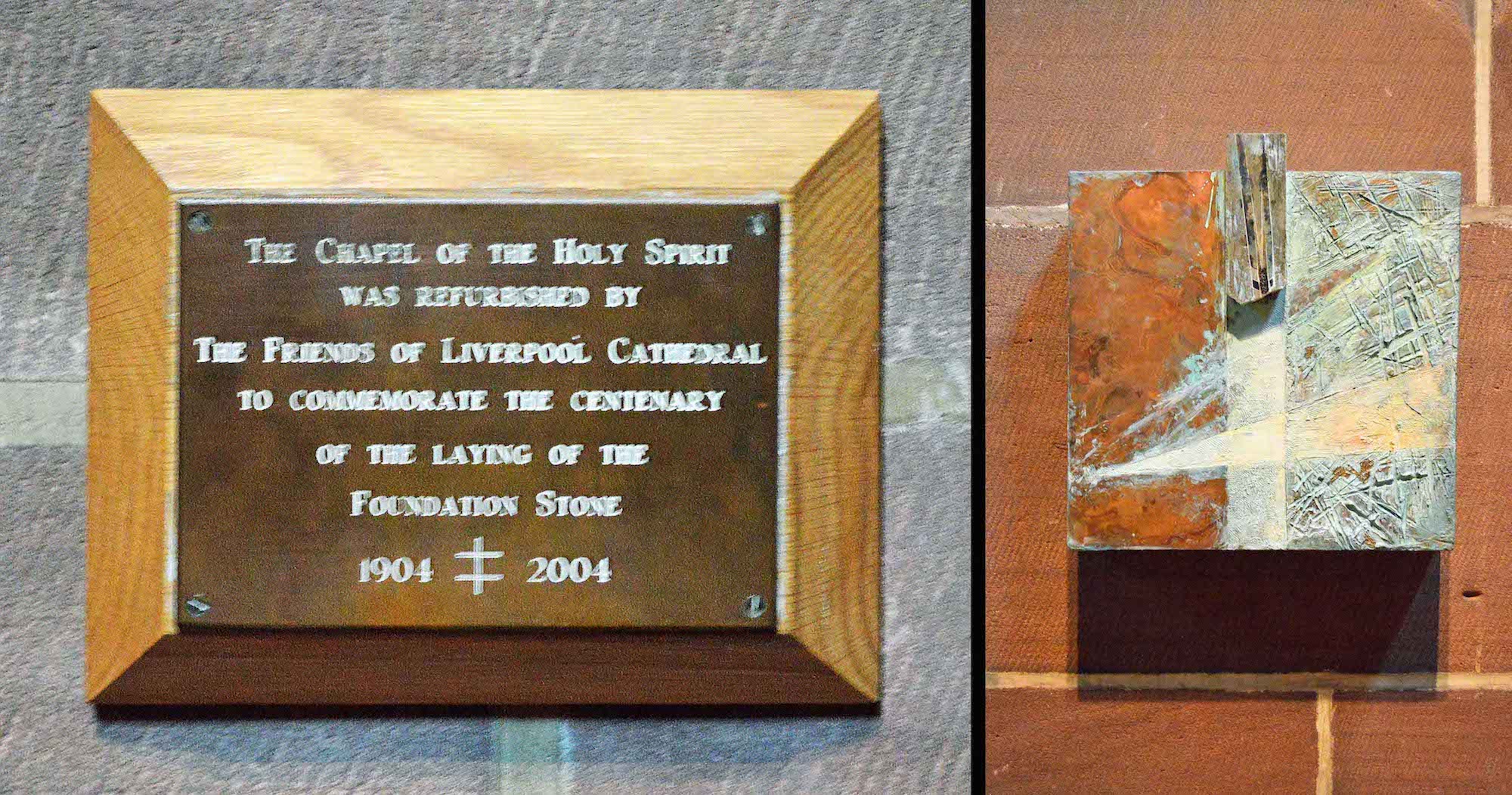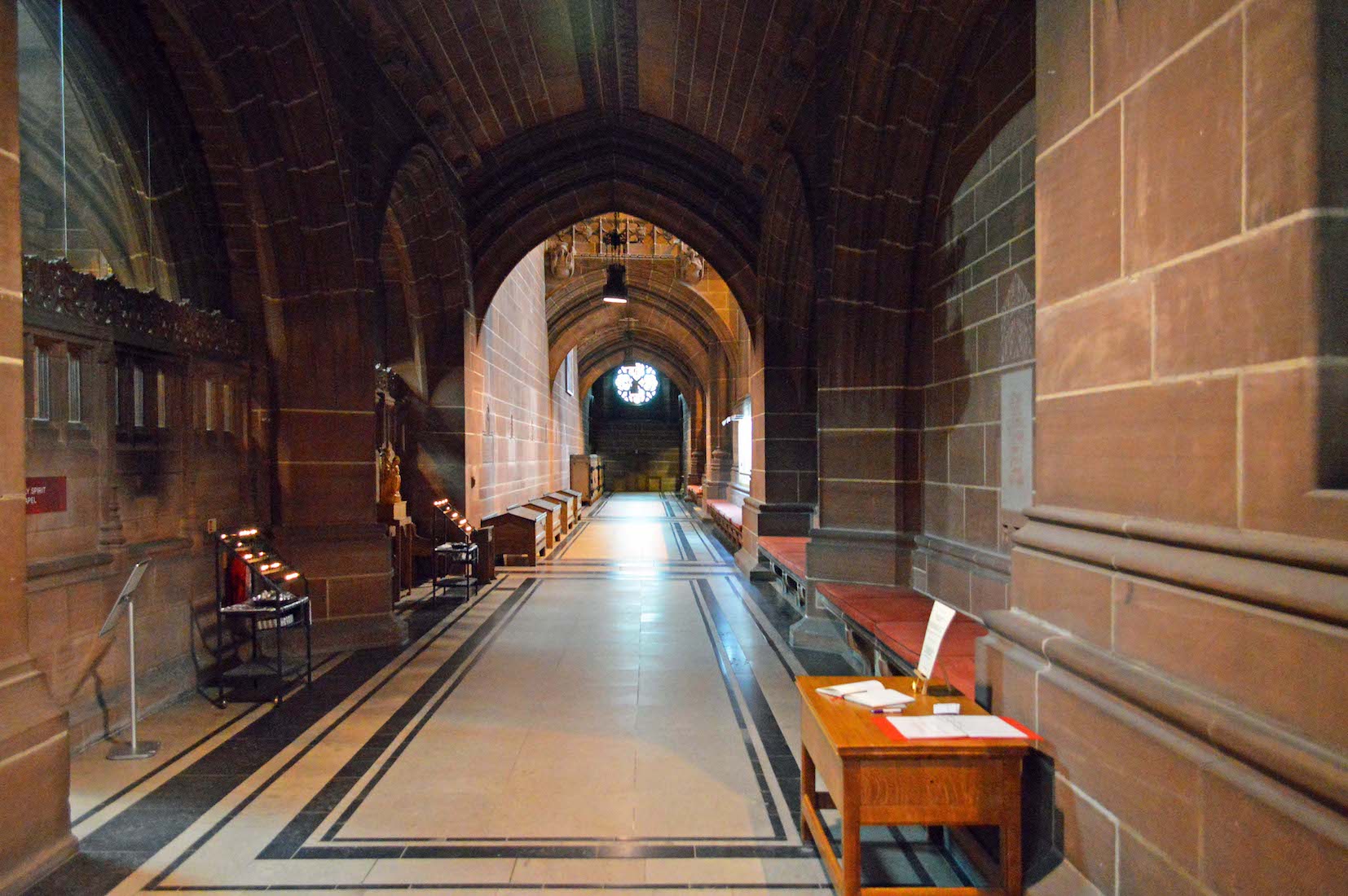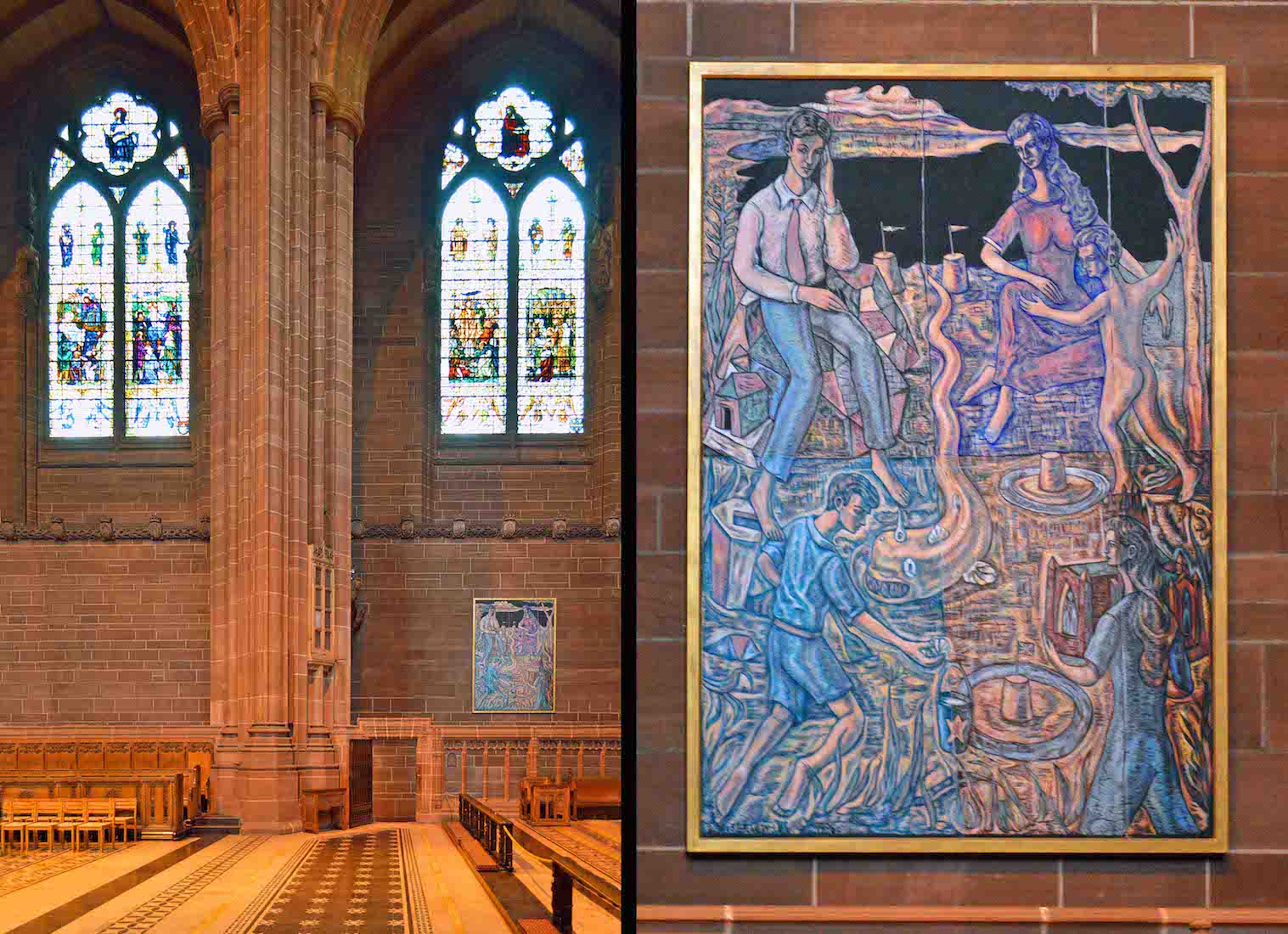41. WAR MEMORIAL CHAPEL REMEMBRANCE STAND

The Memorial Chapel is located in the Northeast transept. In the middle stands this ornately sculpted marble remembrance stand with a book of names of those killed in battle in WWI. PLAN
42. NORTHEAST TRANSEPT WINDOWS

Like the previous transepts we have looked at, this transept has a large end window and two side clerestory strips. Here the clerestory windows show various warlike figures and their crests. The design of the main window was started by Brown and completed by Hogan. It shows suffering and death, including a depiction of the Crucifixion. The original window by Brown was destroyed by bombing; the window replacing it shows Christ with his arms outstretched in welcome at the top.
43. NORTHEAST TRANSEPT ENTRY, ORGAN
We now look at the lower features of this transept. First there is one of the two consoles of the Cathedral organ. Henry Willis began the construction of the organ in 1923, and part of the organ was used at the consecration of the Cathedral in the following year. When completed in 1926, the organ was the largest musical instrument ever conceived, and, since the installation of this Central division in 2007, it continues to be the largest pipe organ in the UK.
44. MEMORIAL CHAPEL WEST ARCH
The West arch in the Memorial Chapel is set aside for remembrance of those in the Royal Air Force who gave their lives in battle. Various colours hang above, there is a memorial plaque and a remembrance book, and to the right, an old wooden propeller.
45. MEMORIAL CHAPEL ALTAR
Against the North wall is a simple altar bearing a cross and two candlesticks. Above (shown at left) is a tastefully designed reredos with a cross and two palm leaves flanked by military figures. And high above is the transept window (#42) with its theme of suffering and death ... and perhaps victory and hope?
46. MEMORIAL CHAPEL EAST ARCH
In the Eastern arch of the chapel is a dedication which reads: ‘This Chapel is dedicated to the glory of God and in memory of the men of Liverpool and District who laid down their lives in the Great War 1914–1918.’ There are regimental colours hanging, a remembrance book, a photographic display, and a soldier’s memorial.
47. CHAPEL HONOURS ROLLS
In more detail, the book in the wall niche gives the names, ranks and army numbers of those who died. The Honours Roll on the stand gives the names and ranks in beautifully illuminated script. The soldier looks so young ... . We leave the Memorial Chapel, and move across to the Southeast transept directly opposite.
48. SOUTHEAST TRANSEPT WINDOWS
We again have the main window and high clerestory windows, and also a war memorial. The clerestory windows depict various crests and four figures including St Silas and St Philip. The central window shows two scenes from the life of Christ, and pictures of the parables of the Good Samaritan and the Sower. The War Memorial remembers the 55th Division. The 165th (Liverpool) Brigade was an infantry brigade of the British Army that served during WWI. The brigade was part of the 55th (West Lancashire) Infantry Division.
49. SOUTHEAST TRANSEPT EAST ARCH
On the East side of the transept is a large arch in which lies an effigy of Frederick Arthur Stanley, 16th Earl of Derby, KG, GCB, GCVO, PC (1841 – 1908). He served as a British politician and in later life was Lord Mayor of Liverpool and the first Chancellor of the University of Liverpool.
50. COPE CHEST
Beyond the effigy is a large cope chest, used for storing ecclesiastical garments. A plaque on the wall behind honours Admiral Sir Max Horton GCB DSO who was Commander in Chief of the Western Approaches 1942 – 1945. The chest has a glass lid beneath which is the material on the right.
51. SOUTHEAST TRANSEPT CRUCIFIX
In the corner of this transept is this art work, ‘The Outraged Christ’ by Charles Lutyens. It was 35 years in the making and depicts an alternate and challenging view of the Crucifixion. It depicts a muscular, angry Christ who looks almost ready to leap from the cross. The relevance of the question that the artist poses with this piece, ‘What are we doing?’ resonates deeply in a society that currently diagnoses itself as ‘sick’ or ‘broken’. The much larger than-life Outraged Christ is made of carved and recycled timber shaped in the form of slats.
52. NORTH AMBULATORY, ORGAN PIPES
Leaving the Southeast transept, we cross back to the North ambulatory, under a stand of organ pipes. The organ is situated in two chambers on opposite sides of the Choir. It currently comprises 10,268 pipes and 200 stops contained in nine divisions. Walking through the arch beneath the pipes, we find a doorway immeiately on our left. This leads to the Holy Spirit Chapel.
53. HOLY SPIRIT CHAPEL
This intimate chapel was not part of the original Cathedral plan, but was added later after the main building opened. Entering the chapel we see the modern, beautifully striking sculpture depicting the ‘veil of the Temple was rent in twain’ and Christ emerging to welcome all who choose to enter. This magnificent piece, entitled ‘Redemption’, was the result of a collaboration between Arthur Dooley and the late Ann McTavish and presented to the Cathedral in 1993, adding to the unique atmosphere of this very special place.
54. THROUGH TO THE INNER HOLY SPIRIT CHAPEL
The Chapel was entirely funded by founder member and executive chairman of the then Cathedral Committee, Sir William Forwood, and the Chapel was screened off in such a way that the grandeur of the main building could still be experienced by those who used it. As we go through the archway to the ‘inner sanctum’ we notice the icons on either side: the Annunciation as the Angel Gabriel speaks to Mary, and the Baptism of Jesus by John the Baptist.
55. CHAPEL PAINTING
Within the inner part of the Chapel is this exquisite gold framed relief of Christ praying in the Garden of Gethsemane, sculpted by William Gough. A simple altar sits in front of it. This is a place for meditation and reflection.
56. HOLY SPIRIT CHAPEL, LOOKING BACK
Returning through the arch we notice a further two icons flanking the doorway – Christ on the left, and St Mary with the Child Jesus at right. Beyown the arch there is a plaque at left and an artwork on the facing wall.
57. HOLY SPIRIT CHAPEL PLAQUE, ARTWORK
The plaque commemorates the refurbishing of the Lady Chapel by the Friends of the Cathedral in 2004. This was on the anniversary of the laying of the Cathedral foundation stone in 1904. I can find no information about the small artwork: the cross? darkness and light? the roughness of the cross?
58. NORTH AMBULATORY
We return to the North ambulatory to continue our investigation. Ahead on the left is a wooden statue. Further on is a decorated arch, then a painting on the left wall, and facing us in the distance, a rose window.
59. MADONNA AND ARCH
The statue is of the Madonna and the Child Jesus. Mary wears a crown and carries a branch that has fruited – a reference to the old Joseph legend. The Child Jesus carries a small book imprinted with a cross. Mary’s shoe is worn smooth with the touch of many visitors, and appears to be resting on a frog. The arch shows two angelic musicians and a number of small decorations.
60. NORTH AMBULATORY FROM THE SANCTUARY
From the sanctuary we can look out on the East end of the North ambulatory to view the painting, and its position with respect to two ambulatory windows. The painting ‘House Built on Rock’ is by Adrian Wiszniewski (b. 1958, British). Critics have often said that Wiszniewski’s work has a poetic quality to it; describing it as belonging to the 19th-century romantic tradition in British art.


